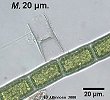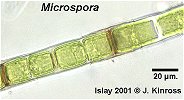FILAMENTOUS ALGAL SPECIES COMMON IN ACID AND SOFT WATERS.
Descriptions of operational taxa found in field studies in Scotland.
(Loch
Ard area of The Trossachs, Galloway, Islay, Morar and Glenelg:
Kinross, 1985, 1991 and unpublished data)
LIST
Microsporales
35-38 = Microspora
Microspora species are unbranched filaments, some at least having the capability in culture to attach to surfaces by a specialized basal cell, following zoospore germination. In field samples however they are almost always found entangled in mosses and liverworts and their original point of attachment is not discernible. Their distribution is therefore linked to those waters where mosses and liverworts are plentiful, and usually to quite humic waters.
The cells are encased in walls composed of H-shaped segments, and in the species found, these segments may normally be distinguished under the microscope. However senescent plants show a degenerate morphology in which the chloroplast, normally a plate or complex network filling the cell, becomes contracted and the wall material becomes swollen and hyaline. The H-segments may be invisible, making the morphology of the filament similar to that described forBinuclearia (Prescott, 1970). There is a possibility of confusing Microspora and Binuclearia species. This is primarily a problem with the 8Ám wide taxa of these two genera. The taxa of Microspora recognized from the Loch Ard study are:
35 = Microspora 8Ám. diameter; possibly M. tumidula. Hazen
John
Kinross




